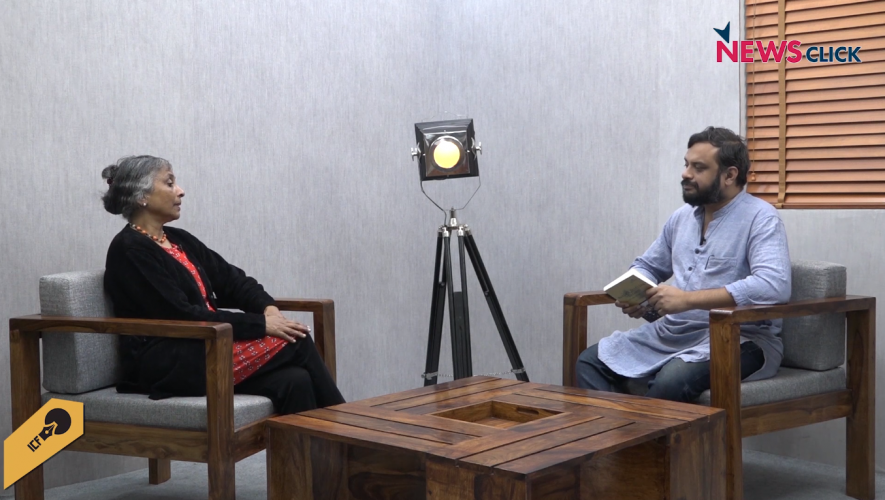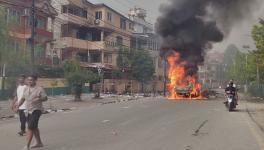The “Mediatisation” of Indian Society

The “Mediatisation” of Indian Society
Written by Pamela Philipose, Media’s Shifting Terrain: Five Years that Transformed the Way India Communicates explores the social and political impacts of this media convergence between 2011 and 2015, through a study of five media-driven mobilisations that transformed India’s public culture. Below is a conversation between Prasanth R and Pamela Philipose, followed by excerpts from the chapter“Scripts, Tweets, Posts, and Verdicts: Electoral Discourse in a Mediatised Age—I” of the book.
Elections are symbolic affirmations of a country’s functioning democracy. Yet, in a very real sense, they also reflect assertions of asymmetrical power that contribute to legitimising the decision-making authority of those who stand for office and win…The media, which once functioned as merely channels of communication within the election process, have now emerged as independent power centres operating ‘autonomously, according to its own economic and symbolic logics’.1
The capacity of the media to set political agendas, which has been defined as the ‘assignment of special relevance to one particular issue or set of information by the source of the message … with the expectation that the audience will respond with heightened attention to the content and format of the message’,2 has also been noted.
The Early Modi
The media access was exploited not only for party publicity, but was also used to take on his political rivals and help his own ascendance to power, as Modi himself has publicly acknowledged. Among his rivals was former mentor Keshubhai Patel, who was then the chief minister of Gujarat. A well-known editor of a national magazine, the late Vinod Mehta, recalled Modi having visited him in his office with ‘a file containing damaging material about the sitting Gujarat chief minister Keshubhai Patel … The next thing I heard was that he had become the chief minister in place of Keshubhai’, Mehta wrote.3
Media access also offered Modi an opportunity to project his own ideological convictions. The party press conferences held by the BJP in Delhi during the Kargil war of 1999 were exercises in jingoism and nationalism. During television appearances, he conveyed his opinions unambiguously. Asked during one TV debate about how to respond to provocations from Pakistan, his answer was: ‘Chicken biryani nahi, bullet ka jawab bomb se diya jayega—we won’t give them chicken biryani, we will respond to a bullet with a bomb.’4 Another instance of such direct speaking was when he was a guest on a prominent news show after the Twin Towers in New York were attacked. He is quoted as having said, ‘It has taken an attack like 9/11 for India’s pseudo-secular media to finally use a word like Islamic terrorism …’.5
Gujarat Pogrom
The curiosity in the media that Modi initially attracted could be attributed partly to the fact that it was for the first time that an RSS pracharak had made it to the high office of chief minister. But the events that took place four months later—the burning of coach S6 of the Sabarmati Express at Godhra, resulting in the deaths of fifty-nine Hindu pilgrims on 27 February 2002, and the communal pogrom that engulfed the state from the following day—were to change irrevocably the manner in which the media framed him. He emerged from that interregnum as a deeply polarising figure: painted as a champion of Hindu, defender of Gujarati pride, by one section of the media; and as a betrayer of the constitutional responsibility to protect minorities and complicit in the genocidal violence that ravaged Gujarat, by another section. In defending himself against the criticism of the latter group, Modi invariably used arguments that resonated with the former…
One senior journalist who was at the receiving end of state hostility—his channel was even banned for a day—had observed, ‘by attempting to pigeonhole a section of the media as the so-called “secular Taliban”, the aim appears to be to create a divide between the Hindutva patriots versus the anti-national pseudo-secularists’.6
Use of Digital Media
It was the use of digital media for controlled communication, however, that came to define Modi’s communications strategy. Digital media served a dual, if contradictory, purpose. On the one hand it made him appear approachable and ready to engage with people; on the other, it precluded the necessity of having to really engage with the mainstream media. Communication scholars have defined Modi’s use of Twitter as ‘part of a larger theatrical of political narrative that reinvents the political actor and what he represents through a relatively manageable media outlet that at once allows for one-way pronouncements alongside the spectre of interactive conversation’7…
Apart from marshalling a wide range of digital platforms for his media game plan, care was taken to ensure the timeliness of the messages. The synchronisation of the message with actual developments taking place on the ground has been regarded by communication strategists as key to its success. This was a lesson learnt by the Gujarat chief minister from the days of the post-Godhra violence, when the powerful counter-narrative to mainstream media content generated by his state information department could win him wide public support. One digital media options were available, Modi was quick to use blogs, posts, and tweets for essentially the same purpose.
India’s Most Mediatised General Election
Journalists covering the event organised for the release of the BJP manifesto in April 2014 were handed over a pen drive carrying the manifesto and a small video on the party. The event itself was featured in newspapers, television, and social media sites like Facebook, and publicised on WhatsApp and through mobile dial-ins.
The publicity was based on the proactive strategy of ‘replicate and pervade’,8 so that its information got stamped on popular consciousness. One scholarly journal editorialised:
If Modi holograms and masks served as evocative substitues to his physical presence in mass rallies, his virtual presence loomed large across the media. Even in the regional language media, both television and print, while local issues naturally occupied centre stage and even where the BJP may have had little or a marginal scope or role, the Modi factor, like a subliminal awareness, informed the proceedings.9
Such nuanced critique was rare. Most publications adopted a stance of consistent, sometimes fulsome, support for Modi. The Dainik Jagran editorial that greeted the Modi victory could be seen as representative of the sentiments prevailing in the Hindi print media as a whole. Titled ‘Janata ka Jawab’ (The people’s answer), it noted that Modi had been ‘ridiculed on many occasions, even at times being insulted and cast as a tyrant by many so-called intellectuals in India and abroad. To them Modi has given an apt answer by winning with a handsome margin’. The implication here was that the ‘handsome’ victory was sufficient in itself to validate the new prime minister, no matter what his historical record may have been.
Television channels, some of which had mounted a no-holds-barred scrutiny of Modi’s handling of the 2002 massacres twelve years earlier, had by 2014 turned into unabashed votaries of his prime ministerial candidature. A combination of powerful corporate support for the Modi candidature—the stock markets greeted his victory with a 5 per cent jump—and a perception that his popularity was good for TRPs and reader interest made for the har-nosed calculus behind such coverage. Sardesai writes how ‘TV channels aired Modi’s speech without any advertising breaks (it would become a familiar practice over the next 12 months, causing loss in revenues to news channels) … In the TRP (Television Rating Point) war, Modi was already the winner.’10
All this was testimony to the chief protagonist’s skilful management of the television media. Those media houses that were seen as recalcitrant and critical were punished through the simple expedient of being boycotted. In the run-up to the 2014 elections, when Modi allowed himself to be open to television interviews, his resentments were made clear. NDTV, for instance, was the only major news network that was not given an interview, possibly because of his stance on the Gujarat pogrom. In contrast, he extended full cooperation for those who had afforded him soft interviews. An appearance before the victory verdict of 2014 on Rajat Sharma’s Aap ki Adalat on India TV was a case in point. As the channel’s editorial director, who resigned subsequently, was to reveal, the show was designed to showcase the Modi persona to the extent that even the studio audience was packed with Modi supporters, who kept cheering his every word.
Get the latest reports & analysis with people's perspective on Protests, movements & deep analytical videos, discussions of the current affairs in your Telegram app. Subscribe to NewsClick's Telegram channel & get Real-Time updates on stories, as they get published on our website.























